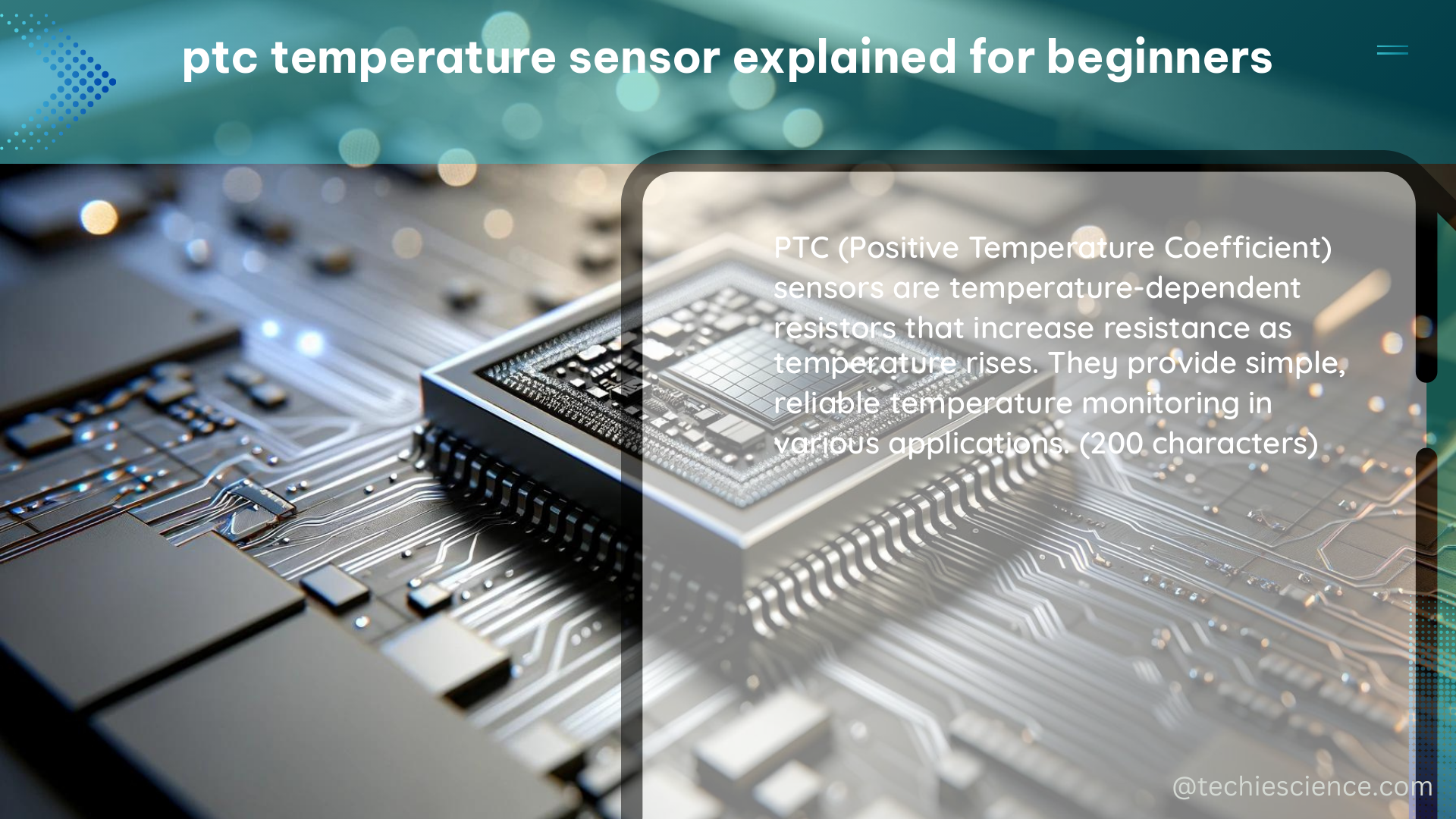A Positive Temperature Coefficient (PTC) temperature sensor, also known as a PTC thermistor, is a type of temperature-dependent resistor that exhibits a significant increase in resistance as the temperature rises above a certain threshold. This unique property makes PTC thermistors suitable for use as temperature protection devices in various applications, including overtemperature protection for transistor circuits, power semiconductor devices, and single-phase/three-phase induction motors.
Understanding PTC Thermistors
PTC thermistors are a type of thermistor, which are electronic components that change their resistance in response to changes in temperature. Unlike Negative Temperature Coefficient (NTC) thermistors, which decrease in resistance as temperature increases, PTC thermistors exhibit a positive temperature coefficient, meaning their resistance increases as the temperature rises.
The resistance-temperature relationship of a PTC thermistor can be described by the following equation:
R = R₀ × exp[B × (1/T – 1/T₀)]
Where:
– R is the resistance at temperature T
– R₀ is the resistance at reference temperature T₀
– B is the material-dependent constant
– T is the absolute temperature in Kelvin
The key characteristic of a PTC thermistor is its sharp increase in resistance at a specific temperature, known as the Curie temperature or switching temperature. This sudden change in resistance is caused by a phase transition in the ceramic material used to fabricate the thermistor, typically a barium titanate (BaTiO₃) or strontium titanate (SrTiO₃) compound.
Applications of PTC Thermistors

PTC thermistors are widely used in various applications due to their unique temperature-dependent resistance characteristics. Some of the common applications include:
- Overtemperature Protection:
- PTC thermistors can be used to protect transistor circuits, power semiconductor devices, and single-phase/three-phase induction motors from overheating.
-
When the temperature rises above a certain threshold, the PTC thermistor’s resistance increases, triggering a protective response, such as cutting off the load current or reducing the collector current to prevent further heating.
-
Inrush Current Limiting:
- PTC thermistors can be used to limit the inrush current when a device is powered on, preventing damage to sensitive components.
-
The PTC thermistor’s low resistance at room temperature allows the initial current to flow, but as the temperature rises due to the inrush current, the resistance increases, limiting the current.
-
Temperature Sensing and Monitoring:
- PTC thermistors can be used to measure and monitor temperature in various applications, such as in household appliances, HVAC systems, and industrial equipment.
-
By using a voltage divider circuit, the output voltage can be measured and converted into a temperature reading.
-
Battery Protection:
- PTC thermistors can be used to protect rechargeable batteries from overheating during charging or discharging.
-
When the battery temperature rises above a certain threshold, the PTC thermistor’s resistance increases, reducing the current flow and preventing further heating.
-
Motor Protection:
- PTC thermistors are commonly used in single-phase and three-phase induction motors to protect against overheating.
- When the motor temperature exceeds the PTC thermistor’s switching temperature, the resistance increases, triggering a tripping unit to shut off the power supply and prevent further damage.
Technical Specifications of PTC Thermistors
PTC thermistors have the following technical specifications:
| Specification | Value |
|---|---|
| Temperature Range | Typically within 50°C of a given center temperature |
| Relative Cost | Very inexpensive compared to other temperature sensors |
| Time Constant | 6 to 14 seconds |
| Stability | 0.0009°C |
These specifications make PTC thermistors a popular choice for temperature protection applications that require high sensitivity, durability, and low cost.
Measuring Temperature with PTC Thermistors
To measure temperature using a PTC thermistor, you can use a voltage divider circuit. In this circuit, the PTC thermistor is connected in series with a fixed resistor, and the output voltage is proportional to the temperature.
The voltage divider circuit can be represented by the following equation:
V_out = V_in × (R_PTC / (R_PTC + R_fixed))
Where:
– V_out is the output voltage
– V_in is the input voltage
– R_PTC is the resistance of the PTC thermistor
– R_fixed is the resistance of the fixed resistor
By measuring the output voltage and using the known resistance-temperature relationship of the PTC thermistor, you can calculate the temperature.
It’s important to note that the nonlinear output of PTC thermistors can be both an advantage and a disadvantage, depending on the application. In some cases, the nonlinearity may need to be compensated for using calibration or linearization techniques.
Advantages and Disadvantages of PTC Thermistors
Advantages of PTC Thermistors:
– High sensitivity to temperature changes
– Durable and long-lasting
– Inexpensive compared to other temperature sensors
– Suitable for single-point temperature measurement
– Reliable overtemperature protection
Disadvantages of PTC Thermistors:
– Nonlinear output, which may require compensation
– Limited temperature range (typically within 50°C of a given center temperature)
– Slower response time compared to other temperature sensors (6 to 14 seconds)
Conclusion
PTC thermistors are a versatile and cost-effective temperature sensing solution that find widespread use in various applications, particularly for overtemperature protection. Their unique resistance-temperature characteristics make them well-suited for applications that require high sensitivity, durability, and reliable temperature monitoring and control. By understanding the principles of PTC thermistors and their technical specifications, engineers and hobbyists can effectively utilize these devices in their projects and designs.
References:
- TDK Corporation. (n.d.). Application Note How to use PTC limit temperature sensors. Retrieved from https://product.tdk.com/en/techlibrary/applicationnote/howto_limt-sensor.html
- Wavelength Electronics. (n.d.). Thermistor Basics. Retrieved from https://www.teamwavelength.com/thermistor-basics/
- Seeed Studio. (2020, October 27). Thermistors: NTC and PTC Thermistors Explained. Retrieved from https://www.seeedstudio.com/blog/2020/10/27/thermistors-ntc-and-ptc-thermistors-explained/

The lambdageeks.com Core SME Team is a group of experienced subject matter experts from diverse scientific and technical fields including Physics, Chemistry, Technology,Electronics & Electrical Engineering, Automotive, Mechanical Engineering. Our team collaborates to create high-quality, well-researched articles on a wide range of science and technology topics for the lambdageeks.com website.
All Our Senior SME are having more than 7 Years of experience in the respective fields . They are either Working Industry Professionals or assocaited With different Universities. Refer Our Authors Page to get to know About our Core SMEs.